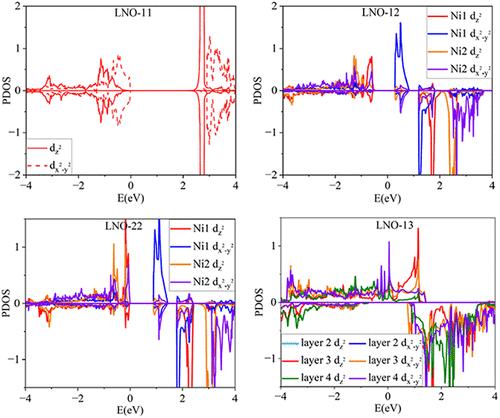Ruddlesden-Popper镧镍酸盐的第一性原理计算的磁性和电子性质
IF 3.2
3区 化学
Q2 CHEMISTRY, PHYSICAL
引用次数: 0
摘要
据报道,双层Ruddlesden-Popper (RP)镍酸盐La3Ni2O7在压力下表现出约80k的高超导转变温度。此外,还合成了多种具有长程结构序的RP镍酸盐。本文通过第一性原理计算,系统地研究了RP型镧镍酸盐的磁性和电子性能,包括La2NiO4(单层NiO6块LNO-11)、La2NiO4·La3Ni2O7(单层和双层NiO6块LNO-12)、La3Ni2O7(单层和三层NiO6块LNO-13)和双层La3Ni2O7(单层NiO6块LNO-22)。我们的研究结果表明,RP结构的组成层中的磁耦合和电子结构与组成层的厚度有关。随着组成层厚度的增加,组成层内的磁耦合呈现出反铁磁(AFM)向铁磁(FM)的转变。LNO-11、LNO-12和LNO-13的组成层呈AFM顺序。LNO-12和LNO-22中Ni2+和Ni3+电荷有序的组成双分子层呈条形有序。LNO-13的组成层表现出铁磁耦合。随着双层结构厚度的增加,RP镍酸盐的电子结构呈现出绝缘体-金属的转变。具有Ni2+和Ni3+电荷顺序的LNO-11、LNO-12和LNO-22具有绝缘性,而没有电荷顺序的LNO-22和LNO-13具有金属性。我们的工作为研究混合堆叠镍酸盐超导体的超导机制提供了潜在的理论参考。本文章由计算机程序翻译,如有差异,请以英文原文为准。

Magnetic and Electronic Properties in Ruddlesden–Popper Lanthanum Nickelates from First-Principles Calculations
The bilayer Ruddlesden–Popper (RP) nickelate La3Ni2O7 has been reported to exhibit a high superconducting transition temperature of approximately 80 K under pressure. Furthermore, different kinds of RP nickelates with long-range structural order have been synthesized. Here, by performing first-principles calculations, we systematically investigate the magnetic and electronic properties of RP lanthanum nickelates, including La2NiO4 (stacked with a monolayer of NiO6 blocks, LNO-11), La2NiO4·La3Ni2O7 (stacked with a monolayer and a bilayer of NiO6 blocks, LNO-12), La3Ni2O7 (stacked with a monolayer and a trilayer of NiO6 blocks, LNO-13) and bilayer La3Ni2O7 (stacked with a bilayer of NiO6 blocks, LNO-22). Our results show that the magnetic coupling and electronic structure in the constituent layers of the RP structure are dependent on the thickness of the constituent layers. The magnetic coupling in the constituent layers displays an antiferromagnetic (AFM) to ferromagnetic (FM) transition with the increase of the thickness of the constituent layers. The constituent monolayer in LNO-11, LNO-12, and LNO-13 shows an AFM order. The constituent bilayer with charge ordering of Ni2+ and Ni3+ in LNO-12 and LNO-22 displays a stripe order. The constituent trilayer in LNO-13 exhibits a ferromagnetic coupling. Furthermore, the electronic structures of RP nickelate show an insulator–metal transition with the increase of the thickness of the constituent bilayer. LNO-11, LNO-12, and LNO-22 with charge ordering of Ni2+ and Ni3+ are insulating, while LNO-22 without charge ordering and LNO-13 become metallic. Our work potentially provides insight into the mechanism of superconductivity and a theoretical reference for studying mixed-stacked nickelate superconductors.
求助全文
通过发布文献求助,成功后即可免费获取论文全文。
去求助
来源期刊

The Journal of Physical Chemistry C
化学-材料科学:综合
CiteScore
6.50
自引率
8.10%
发文量
2047
审稿时长
1.8 months
期刊介绍:
The Journal of Physical Chemistry A/B/C is devoted to reporting new and original experimental and theoretical basic research of interest to physical chemists, biophysical chemists, and chemical physicists.
 求助内容:
求助内容: 应助结果提醒方式:
应助结果提醒方式:


